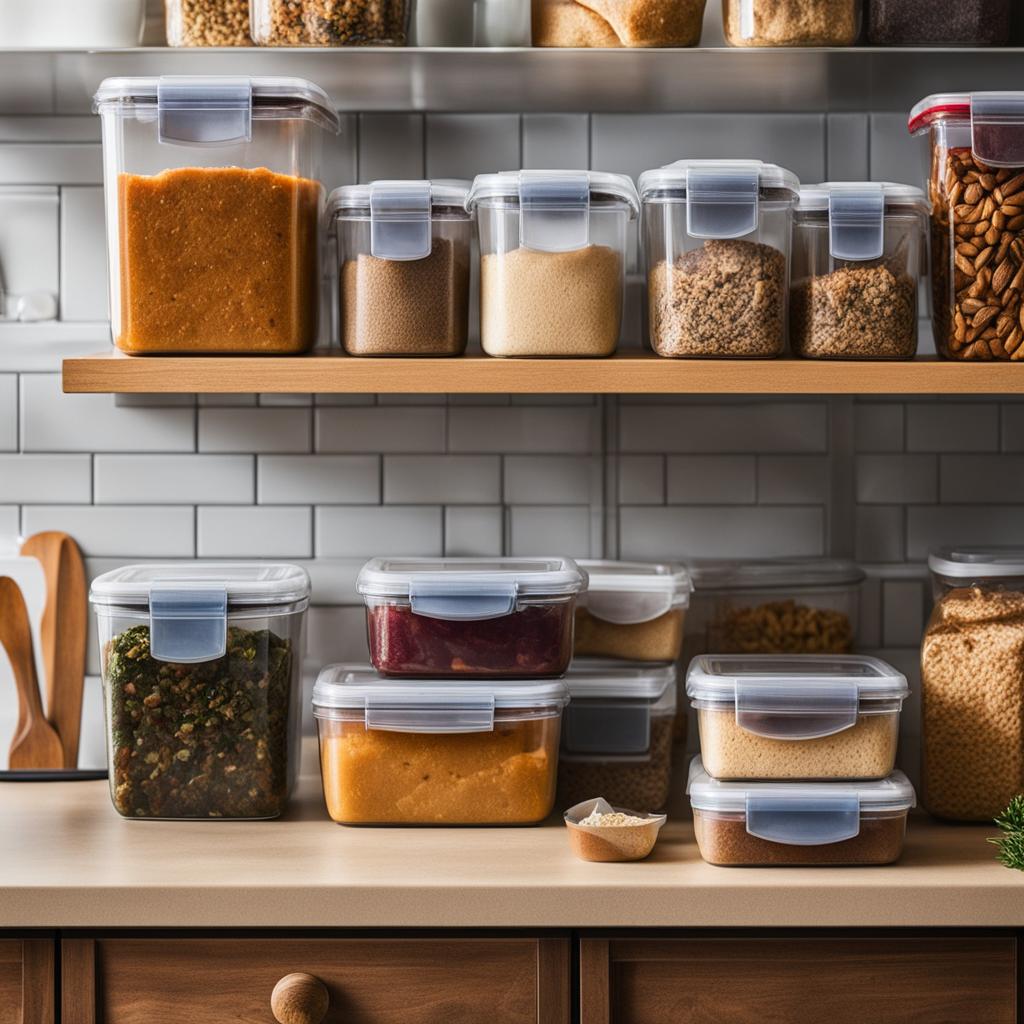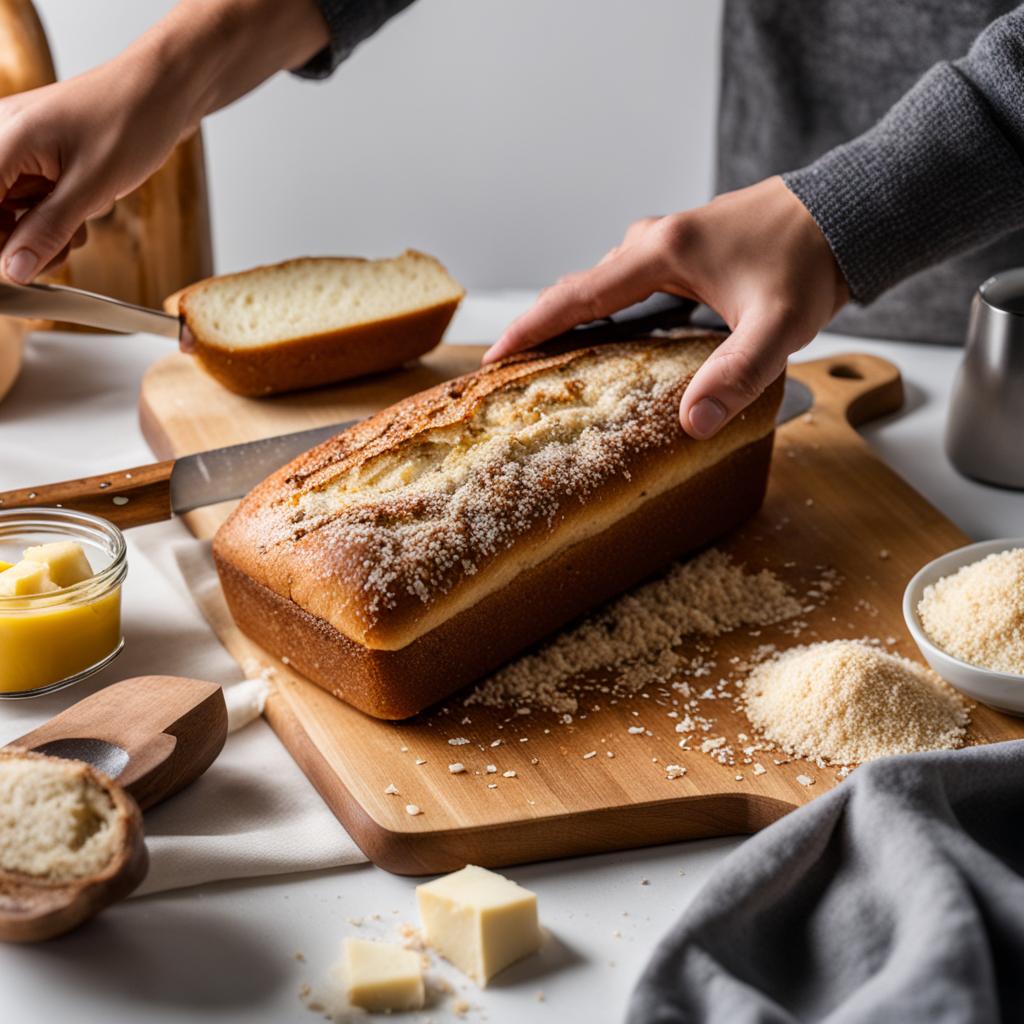Storing bread properly is essential to preserve its freshness and taste. By following these tips, you can ensure that your bread stays fresh for longer and remains enjoyable to eat. Let’s explore the best methods and techniques for storing bread in your kitchen.
Key Takeaways:
- Properly storing bread can help preserve its freshness and taste.
- Freezing bread is the best method for long-term storage.
- Avoid storing bread in plastic bags to prevent mold formation.
- Consider using a bread box to maintain optimal humidity levels.
- Store bread in a cool, dry area of your kitchen, away from heat and moisture.
The Best Way to Preserve Bread – Freezing
When it comes to preserving bread and extending its freshness, freezing is the best method. Freezing bread not only helps to maintain its taste and texture but also allows you to enjoy it for a longer period of time. To freeze bread effectively, follow these simple steps:
- Wrap the bread tightly in a freezer bag to prevent freezer burn. If you prefer to slice the bread before freezing, place wax paper between the slices for easier portioning.
- When it’s time to defrost the bread, the best method is to thaw it overnight in the refrigerator. This helps to prevent sogginess and ensures that the bread retains its freshness.
- If you’re in a hurry, you can also toast slices of frozen bread directly from the freezer. Simply pop them in the toaster or toaster oven for a quick and convenient way to enjoy freshly baked bread.
- If you have a whole frozen loaf, you can bake it at 325 degrees Fahrenheit for 25 to 30 minutes. This will not only thaw the bread but also reheat it, giving you a warm and delicious loaf.
Freezing bread is a fantastic way to preserve its freshness and have it readily available whenever you need it. Whether you choose to freeze whole loaves or sliced bread, this method ensures that your bread stays delicious and ready to enjoy.
| Freezing Tips | Benefits |
|---|---|
| Wrap bread tightly in a freezer bag | Prevents freezer burn |
| Thaw overnight in the refrigerator | Prevents sogginess |
| Toasts slices directly from the freezer | Quick and convenient |
| Bake whole frozen loaf at 325°F | Thaws and reheats the bread |
By following these freezing tips, you can prolong the shelf life of your bread and always have a tasty supply on hand. Whether you’re making sandwiches or enjoying a slice of toast, frozen bread is a convenient and delicious option that ensures you never have to waste a single crumb.
Avoid Plastic and Use Paper Bags on the Counter
When it comes to storing bread on the counter, opting for paper bags rather than plastic bags can make a significant difference in its freshness and mold prevention. Plastic bags can trap moisture and create a humid environment, promoting mold growth and leading to faster spoilage. By using paper bags, you allow for better airflow around the bread, maintaining its freshness for a longer period of time.
“Storing bread in plastic bags can encourage mold growth and result in faster spoilage.”
Another tip to preserve the cut side of the loaf is to use the bread’s heels as covers. By placing the crusty ends of the bread back over the cut side, you minimize its exposure to air and help maintain its freshness. This simple trick can significantly extend the shelf life of your bread.
So, the next time you bring home a fresh loaf of bread, reach for a paper bag instead of a plastic one. Your bread will thank you for it, staying mold-free and delicious on your countertop.
| Plastic Bags | Paper Bags |
|---|---|
| Trap moisture | Allow for better airflow |
| Promote mold growth | Help maintain freshness |
| Result in faster spoilage | Extend the shelf life of bread |
Benefits of using paper bags:
- Improved airflow
- Reduced mold growth
- Extended freshness
By following this simple storage tip, you can enjoy fresh, mold-free bread for longer periods, ensuring every bite is as delicious as the first.
The Benefits of Bread Boxes
When it comes to storing bread, a bread box can be a game-changer. Not only do bread boxes provide a convenient storage solution, but they also offer several benefits for preserving the freshness and quality of your bread.
Preserving Humidity
Bread boxes are designed to maintain a balanced level of humidity, which is essential for keeping bread fresh. The small holes or vents in a bread box allow for proper airflow, preventing excess moisture buildup that can lead to mold growth. By regulating humidity, bread boxes help extend the shelf life of your bread while keeping it deliciously moist.
Maintaining Crustiness
The controlled airflow in a bread box also helps preserve the crustiness of your bread. The crust is an integral part of the bread-eating experience, providing a satisfying crunch and protecting the soft interior. By preventing excessive moisture loss, bread boxes help maintain the perfect balance of a crispy crust and a tender crumb.
Choosing the Right Size
When selecting a bread box, it’s important to choose the right size for optimal freshness. A larger bread box allows for more air circulation, ensuring that your bread stays fresh for longer. However, be mindful of not overfilling the bread box, as overcrowding can affect the humidity level inside. By finding the right balance, you can enjoy the benefits of a bread box and prolong the enjoyment of your bread.
| Benefits of Bread Boxes |
|---|
| Preserves humidity, preventing mold growth |
| Maintains the crustiness of bread |
| Allows for controlled airflow |
| Comes in various sizes for optimal freshness |
Proper Storage Locations
When it comes to storing bread, choosing the right location is crucial to maintain its freshness and flavor. Here are some optimal storage options for different types of bread:
Pantry:
If you plan to consume the bread within a few days, storing it in a cool and dry pantry is a great choice. Make sure to place it away from direct sunlight and heat sources like stovetops and ovens.
Refrigerator:
While refrigeration can prolong the shelf life of bread, it may also accelerate staling, particularly for certain types like artisanal bread with a crispy crust. If you live in a humid climate or want to extend the bread’s freshness, storing it in the refrigerator can be beneficial. However, keep in mind that refrigerated bread tends to dry out more quickly.
Freezer:
The freezer is an excellent option for long-term bread storage. If you don’t plan to consume the bread within a week, consider freezing it. Wrap the bread tightly in plastic wrap or aluminum foil to prevent freezer burn. It’s also a good idea to slice the bread before freezing, so you can easily thaw individual portions as needed.
Counter:
If you consume bread quickly and prefer to have it readily accessible, storing it on the counter can be convenient. However, keep in mind that the shelf life of bread stored on the counter is shorter compared to other storage methods. To maintain freshness, opt for a bread box or use paper bags to allow for proper airflow and prevent mold growth.
Choose the storage location that best suits your needs and the type of bread you have. Experiment with different methods to find what works best for you and enjoy fresh, delicious bread for longer periods.
| Storage Location | Advantages | Disadvantages |
|---|---|---|
| Pantry | – Convenient access | – Shorter shelf life |
| Refrigerator | – Delays mold growth | – Accelerates staling |
| Freezer | – Long-term storage | – Texture may change upon thawing |
| Counter | – Immediate accessibility | – Shorter shelf life |
Each storage method has its pros and cons, so consider your preferences and the type of bread you have before deciding on the best storage location.
Long-Term Storage Solutions
When it comes to long-term storage of bread, the freezer is your best friend. Freezing bread can extend its shelf life for up to two to three months, ensuring that you always have a fresh loaf on hand. To freeze bread, wrap it tightly in a freezer bag, making sure to remove as much air as possible. Alternatively, you can slice the bread beforehand and place wax paper between the slices for easier portioning.
When you’re ready to enjoy your frozen bread, there are a few options for defrosting. For the best texture, it’s recommended to thaw the whole loaf overnight in the refrigerator. This gentle thawing process helps preserve the moisture and prevent sogginess. However, if you’re in a hurry, you can also toast slices of bread directly from the freezer or bake a whole frozen loaf in the oven at 325 degrees for 25 to 30 minutes.
It’s important to note that while freezing can prolong the shelf life of bread, there is a limit. Beyond two to three months, the quality and taste of the bread may start to deteriorate. For the freshest bread, it’s best to purchase or bake it fresh as needed. Commercially yeasted bread typically has a shorter shelf life compared to sourdough bread, so consider investing in a bread maker if you enjoy homemade loaves and want to have access to fresh bread at any time.

Table: Comparing Long-Term Storage Methods
| Storage Method | Shelf Life | Best for |
|---|---|---|
| Freezing | 2-3 months | Preserving freshness for an extended period |
| Refrigeration | 1-2 weeks | Short-term storage when quick access is needed |
| Room Temperature | 3-7 days | Immediate consumption |
“Freezing bread is a game-changer when it comes to long-term storage. It allows you to stock up on your favorite loaves and never worry about running out. Just remember to properly wrap the bread to prevent freezer burn and thaw it in the refrigerator for the best results.” – Chef Emily
By understanding the best long-term storage solutions for bread, you can ensure that you always have fresh and delicious loaves on hand. Freezing your bread is the most effective method for preserving its freshness, with a shelf life of up to two to three months. Whether you choose to thaw the whole loaf or toast slices directly from the freezer, freezing allows you to enjoy bread whenever you want. Remember the limits of long-term storage and aim for the freshest bread by purchasing or baking it fresh as needed.
The Science Behind Staling
Understanding the science behind staling can help you better store bread and preserve its freshness. When bread is baked, the starches in the dough undergo a process called gelatinization, where they absorb moisture and swell. However, as the loaf cools, these starches undergo retrogradation, a process where they lose moisture and rearrange themselves into a more rigid structure.
This retrogradation is what leads to the hardening of the crumb and the ruggedness of the crust over time. The loss of moisture and rearrangement of starches result in the bread becoming stale. The rate of staling can be affected by various factors, including the presence of fats in the dough. Bread with a higher fat content tends to stale more slowly, allowing it to stay fresher for longer.
It’s important to note that staling is a natural process and cannot be completely avoided. However, by understanding the science behind it, we can take steps to slow down the staling process and prolong the freshness of our bread. By using proper storage methods and techniques, we can maintain the texture, taste, and quality of our bread for as long as possible.
“By understanding the science behind staling, we can take steps to slow down the process and prolong the freshness of our bread.”
| Factors Affecting Staling | Explanation |
|---|---|
| Moisture content | Bread with higher moisture content tends to stale more slowly. |
| Starch retrogradation | The rearrangement of starch molecules leads to the hardening of the crumb and crust. |
| Fat content | Bread with higher fat content tends to stale more slowly, as fats can delay starch retrogradation. |
| Storage conditions | Properly storing bread in a cool and dry environment can slow down the staling process. |

Factors Affecting Staling
There are several factors that can affect the rate of staling in bread. These include the moisture content, starch retrogradation, fat content, and storage conditions. By understanding these factors, we can make informed decisions about how to store our bread and slow down the staling process.
- Moisture content: Bread with higher moisture content tends to stale more slowly. This is because moisture helps to keep the starches in the bread from retrograding and becoming rigid.
- Starch retrogradation: Retrogradation is the process where the starch molecules in bread rearrange themselves into a more rigid structure. This process leads to the hardening of the crumb and crust, resulting in stale bread.
- Fat content: Bread with a higher fat content tends to stale more slowly because fats can interfere with the retrogradation process. Fats coat the starch molecules, preventing them from coming into contact with each other and delaying the formation of a rigid structure.
- Storage conditions: Properly storing bread in a cool and dry environment can slow down the staling process. Moisture and heat accelerate the retrogradation of starches, so it’s important to keep bread away from humid areas and sources of heat.
Letting Fresh Bread Cool Completely
After taking the bread out of the oven, it’s important to resist the temptation to slice into it right away. Letting fresh bread cool completely is crucial to achieve the desired texture and prevent the interior from being gummy and sticky. The process of cooling allows the starches in the bread to fully set, ensuring a light and airy crumb.
For most bread, waiting at least an hour before slicing is recommended. However, larger loaves or bread with a higher percentage of whole grains may require even more resting time. It’s best to allow the bread to cool for two or more hours, as this will give the starches ample time to undergo retrogradation, which is crucial for achieving the perfect texture.
During retrogradation, the starch molecules in the bread go through a process of rearrangement, resulting in a more stable crumb and a better overall structure. Slicing warm bread too early can disrupt this process and lead to a gummy and sticky interior, which is not ideal for enjoying freshly baked bread.

Cutting and Storing Sliced Bread
When it comes to cutting and storing sliced bread, there are a few key considerations to ensure its freshness and quality. Properly cutting and storing your bread can help maintain the integrity of the crumb and crust, preventing excessive drying. Here are some tips to guide you:
1. Cutting the bread
- After your bread has cooled and fully set, it’s time to cut it.
- Start by cutting the loaf in half, and then turn the halves so that the crumb faces the cutting board.
- This technique creates a natural “bag” with the crust, helping to prevent the bread from drying out.
2. Storing the bread
- Once you’ve cut your bread, it’s important to store it properly to maintain its freshness.
- Keeping the cut loaf on the counter, preferably in a bread box, can help maintain freshness and protect it from excessive drying.
- Alternatively, you can wrap the sliced bread in reusable wrap or plain paper bags to retain its moisture.
- In high-humidity environments, storing sliced bread in the refrigerator may be necessary to prevent molding.
By following these simple steps, you can ensure that your sliced bread stays fresh and delicious for as long as possible. Whether you choose to store it on the counter, in a bread box, or in the refrigerator, proper storage is essential for preserving the taste and texture of your favorite loaf. Enjoy every slice!
| Storage Method | Advantages | Disadvantages |
|---|---|---|
| Counter with bread box | – Maintains freshness and texture – Protects bread from excessive drying |
– Limited storage capacity – May not be suitable for high-humidity environments |
| Reusable wrap or paper bags | – Retains moisture – Eco-friendly option |
– Limited airflow – May require additional protective measures in high-humidity environments |
| Refrigerator | – Prevents molding in high-humidity environments – Extends shelf life |
– Accelerates staling – Can affect taste and texture |
“Properly cutting and storing sliced bread can help maintain its freshness and quality, preserving the taste and texture for longer periods.”

Freezing Individual Slices
When it comes to preserving bread, freezing individual slices is a convenient and practical option. By freezing slices, you can easily have fresh bread whenever you desire without the need to defrost an entire loaf. Here are some simple steps to freeze and enjoy individual slices of bread.
First, slice the loaf completely and stack the slices neatly. Press out as much air as possible from the freezer bag to prevent freezer burn. Seal the bag tightly to maintain freshness. Freezing individual slices allows for easy portion control and minimizes waste. It also eliminates the need to defrost more bread than you need.
To enjoy a perfectly toasted slice of bread, simply take the desired number of slices from the freezer and pop them directly into a toaster. Toasting frozen bread slices results in a freshly baked taste and a crisp texture that enhances your culinary experience. Whether you prefer a light toast or a golden brown crunch, frozen bread slices deliver delicious results.
Plastic bags are ideal for freezing individual bread slices. They are durable and provide a secure seal that prevents moisture or air from affecting the quality of the bread. Additionally, plastic bags can be reused multiple times for freezing slices, making them an environmentally friendly and cost-effective storage solution.
| Benefits of Freezing Individual Slices | Drawbacks of Freezing Individual Slices |
|---|---|
|
|
Freezing individual slices of bread offers convenience and freshness. It allows you to enjoy the taste of freshly baked bread whenever you desire, without the need to defrost an entire loaf. Plastic bags are the perfect storage option for freezing slices, ensuring that your bread remains moist and delicious. So go ahead and stock your freezer with individually frozen slices for a quick and satisfying treat.
Using a Bread Box for Balanced Freshness
When it comes to storing bread, a bread box is a fantastic option that provides a balanced environment for maintaining its freshness. A bread box regulates the humidity levels while allowing proper airflow, which helps preserve the crust and crumb textures of your bread. It creates the perfect conditions to keep your bread tasting delicious for longer.
One of the benefits of using a bread box is that it prevents your bread from drying out too quickly. The controlled humidity inside the box helps to maintain the moisture content, preventing the bread from becoming stale. Additionally, the proper airflow ensures that the crust retains its desired texture, while the crumb remains soft and moist.
When choosing a bread box, opt for a larger size to maximize air circulation. Overfilling the bread box can disrupt the airflow and affect the humidity level, compromising the freshness of your bread. By selecting the right-sized bread box and using it correctly, you can enjoy perfectly balanced and fresh bread every time.
In summary, using a bread box is an excellent way to store your bread and maintain its freshness. The regulated humidity and proper airflow help preserve the crust and crumb textures, ensuring that your bread stays delicious for longer. Remember to choose a larger bread box to allow for optimal air circulation and avoid overfilling it. Invest in a bread box and savor the taste of perfectly fresh bread every day!
Alternatives to Traditional Storage Methods
When it comes to storing bread, there are alternatives to traditional methods that can help keep your loaf fresh and delicious. Consider these options:
- Reusable wrap: Instead of using plastic bags, try wrapping your bread in reusable wrap made from beeswax or fabric. This allows for some airflow while protecting the bread from excessive moisture loss.
- Paper bags: Storing bread in paper bags is another eco-friendly option. Paper bags provide better airflow compared to plastic, helping to maintain freshness.
- Kitchen towels: Wrapping bread in kitchen towels can also help preserve its freshness. Just make sure the towels are clean and dry before using them to wrap the loaf.
- Plastic bag: In certain climates with high humidity, using a sealed plastic bag may be necessary to retain moisture and prevent the bread from drying out too quickly.
- Refrigerator: While storing bread in the refrigerator is not recommended for long-term storage, it can be a temporary solution if you live in a hot or humid environment. Just be aware that refrigeration can accelerate staling, so consume the bread as soon as possible.
Remember, the key to preserving the freshness of bread is to strike a balance between airflow and moisture. Experiment with these alternative storage methods to find the one that works best for you and enjoy bread that stays delicious for longer.
Below is a comprehensive table summarizing the pros and cons of each alternative storage method:
| Storage Method | Pros | Cons |
|---|---|---|
| Reusable wrap | Environmentally friendly, allows for some airflow | May not provide as much moisture retention as other methods |
| Paper bags | Allows for better airflow, eco-friendly | Not as airtight as other methods, may require additional measures to prevent moisture loss |
| Kitchen towels | Can help retain moisture, reusable | Requires regular washing to prevent the transfer of bacteria |
| Plastic bag | Provides a more airtight seal, suitable for high-humidity environments | May trap excess moisture, can contribute to a soggy crust |
| Refrigerator | Temporarily slows down staling, ideal for hot or humid climates | Can accelerate staling, alters texture and flavor |
By exploring these alternatives, you can find the storage method that best suits your needs and ensure that your bread stays fresh and delicious for longer.
Additional Tips for Preserving Bread Freshness:
- Always store bread in a cool and dry place to prevent moisture buildup.
- Avoid exposing bread to direct sunlight as it can cause the crust to become stale.
- Consider slicing and storing only the amount of bread you plan to consume within a day or two to maintain maximum freshness.
- If using plastic bags, make sure they are clean and dry to prevent mold growth.
- If you notice any signs of mold or spoilage, discard the bread immediately to avoid potential health risks.
The Importance of Freshly Baked Bread
When it comes to bread, there’s nothing quite like the taste and freshness of a homemade loaf. Whether you’re an avid baker or just starting out, investing in a bread maker can revolutionize your culinary adventures and elevate your love for bread to new heights.
A bread maker allows you to enjoy the full experience of baking bread, from mixing the dough to savoring the warm, fragrant aroma that fills your kitchen. With just a few simple ingredients and the press of a button, you can create a delicious loaf of bread that is freshly baked and bursting with flavor.
One of the greatest advantages of a bread maker is the ability to customize your loaves. Whether you prefer a classic white bread, a hearty whole grain, or a unique blend of flavors, you have full control over the ingredients and can experiment with different recipes to create the perfect loaf. Plus, with a bread maker, you can easily adjust the size of your loaf to suit your needs, ensuring that you always have the right amount of bread for any occasion.
Taking your love for bread to the next level
A bread maker not only allows you to enjoy the taste of freshly baked bread but also offers convenience and flexibility. You can wake up to the enticing aroma of a warm loaf ready for breakfast or have a fresh batch of bread waiting for you when you return home from work. With the ability to pre-program your bread maker, you can have freshly baked bread whenever you desire.
So why settle for store-bought bread that may have been sitting on the shelves for days when you can savor the unmatched taste and texture of homemade bread? Treat yourself to the experience of baking your own bread with a bread maker and discover the joy of enjoying a warm, freshly baked slice straight from your kitchen.
| Bread Maker Benefits | Features |
|---|---|
| Convenience | Pre-programmed settings for different bread types |
| Customization | Ability to adjust ingredients and loaf size |
| Time-saving | Set it and forget it – your bread maker does the work for you |
| Consistency | Reliable results every time |
| Versatility | Create a variety of breads, from basic loaves to specialty recipes |
“The smell of good bread baking, like the sound of lightly flowing water, is indescribable in its evocation of innocence and delight.” – M.F.K. Fisher
Conclusion
After diving into the world of bread storage, it’s clear that proper techniques can greatly extend the freshness and taste of our beloved loaves. As a culinary enthusiast, I understand the importance of maintaining the quality of our baked goods in the kitchen.
By implementing the tips and tricks shared in this article, you can confidently store your bread and enjoy it to the fullest. Whether you choose to freeze your loaves or use a bread box, the goal is to create an ideal environment that preserves freshness and enhances the overall dining experience.
So, go ahead and savor the delightful flavors and textures of your homemade or store-bought bread. With the right storage methods at your disposal, you can relish every bite without worries of spoilage or loss of freshness. Let’s continue to embrace the joy of baking and elevate our culinary adventures in the kitchen!
FAQ
How should I store bread to preserve its freshness?
The best way to store bread is by freezing it. Wrap it tightly in a freezer bag, either whole or sliced. Thaw the whole loaf overnight in the refrigerator or toast slices directly from the freezer. Another option is to bake a whole frozen loaf at 325 degrees for 25 to 30 minutes.
Can I store bread in plastic bags?
Storing bread in plastic bags can encourage mold growth and result in faster spoilage. Instead, opt for paper bags when storing bread on the counter. Paper bags allow for better airflow and help maintain freshness.
What are the benefits of using a bread box?
Bread boxes are a great option for storing bread as they provide a suitable environment for maintaining humidity levels. They allow for a controlled amount of air circulation, preventing mold formation while preserving crustiness.
Where is the best place to store bread?
Avoid storing bread on top of the refrigerator or near a dishwasher, as the excess heat and moisture can lead to faster spoilage. Instead, opt for a cool and dry area of your kitchen, such as a pantry, cabinet, or deep drawer.
How long can I store bread?
While bread can be frozen for up to two to three months, there is no long-term storage solution beyond this time frame. If you need to store bread for an extended period, it is best to purchase or bake it fresh.
What is the science behind staling?
When bread is baked, the starches in the dough undergo gelatinization, which then undergoes retrogradation as the loaf cools. This retrogradation leads to the hardening of the crumb and the ruggedness of the crust over time.
Is it necessary to let fresh bread cool completely before slicing it?
Yes, it is crucial to let fresh bread cool completely before slicing it. Slicing warm bread too early can result in a gummy and sticky interior due to incomplete retrogradation. Waiting for at least an hour allows the starches to fully set and the bread to develop its desired texture.
How should I cut and store sliced bread?
By cutting the loaf in half and turning the halves so that the crumb faces the cutting board, you can create a natural bag with the crust to prevent excessive drying. Keeping the cut loaf on the counter, preferably in a bread box or wrapped in reusable wrap or plain paper bags, helps maintain freshness.
Can I freeze individual slices of bread?
Yes, freezing individual slices of bread offers convenience and freshness. Slice the bread completely and stack the slices in a freezer bag, pressing out as much air as possible. This method allows you to easily reheat individual slices in a toaster, resulting in a freshly baked taste every time.
How can I store bread without traditional methods?
Reusable wraps, paper bags, and kitchen towels can effectively keep bread from drying excessively. These options allow for some airflow while protecting the bread from excessive moisture loss. In certain climates, sealed plastic bags may be necessary to retain moisture. However, storing bread in the refrigerator is not recommended for long-term storage.
Why is freshly baked bread important?
Nothing beats the taste of freshly baked bread. Investing in a bread maker allows you to enjoy the full freshness of bread and experiment with different flavors and techniques.
Source Links
- https://www.theperfectloaf.com/the-best-way-to-store-bread/
- https://www.foodandwine.com/cooking-techniques/storing-bread-tips
- https://www.epicurious.com/expert-advice/how-to-keep-bread-fresh-article
Related Recipes:
 How to Store Parsley? (Perfect Every Time!)
How to Store Parsley? (Perfect Every Time!)
 Bread Storage: How Long Does Bread Last in the Fridge?
Bread Storage: How Long Does Bread Last in the Fridge?
 How to Store Carrots? (Perfect Every Time!)
How to Store Carrots? (Perfect Every Time!)
 How to Store Baked Goods to Keep Them Fresh
How to Store Baked Goods to Keep Them Fresh
 Can You Freeze Stuffing? How to Preserve the Holiday Dish
Can You Freeze Stuffing? How to Preserve the Holiday Dish
 How to Store Asparagus to Maintain Freshness
How to Store Asparagus to Maintain Freshness
 How to Freeze Bananas? (Perfect Step-By-Step Guide)
How to Freeze Bananas? (Perfect Step-By-Step Guide)
 How to Store Berries and Keep Them Fresh
How to Store Berries and Keep Them Fresh








